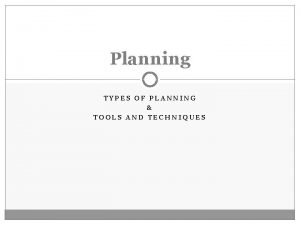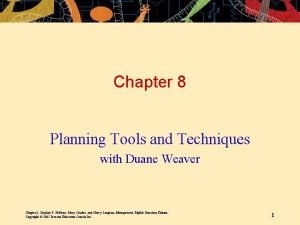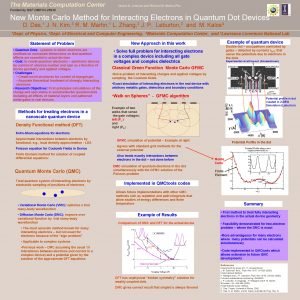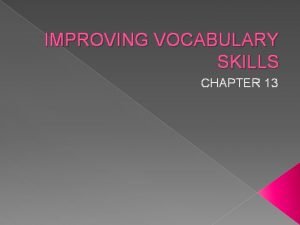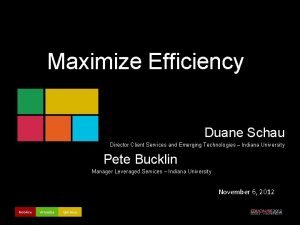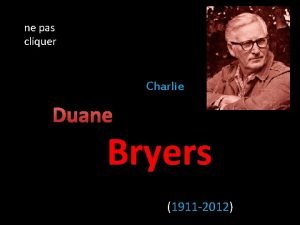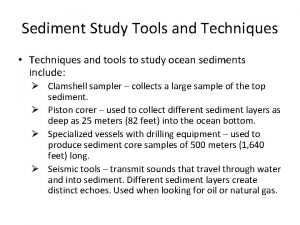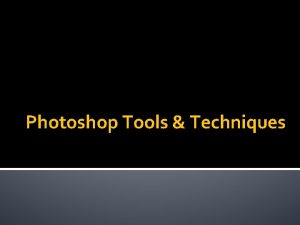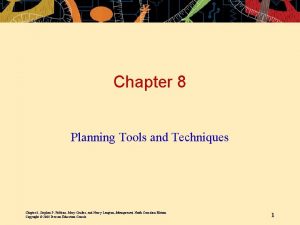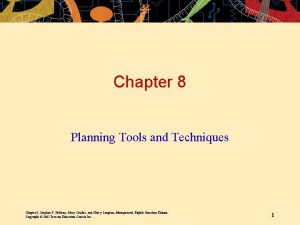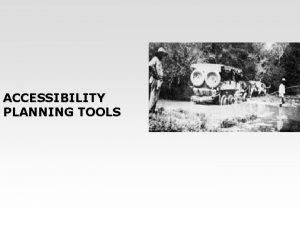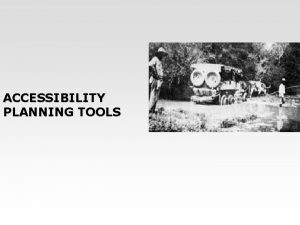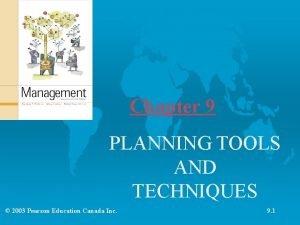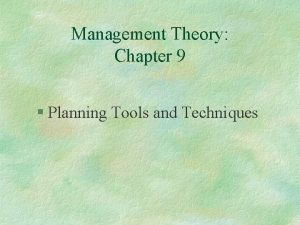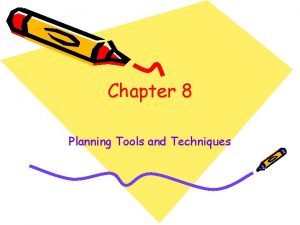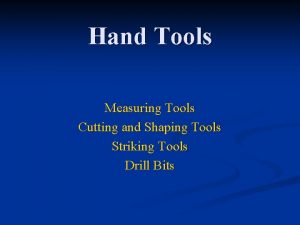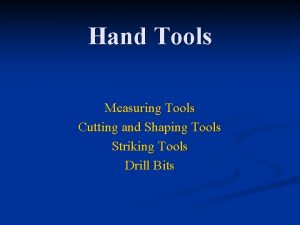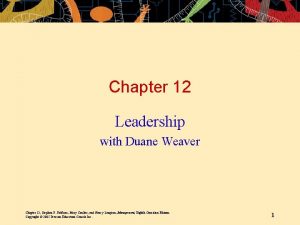Chapter 8 Planning Tools and Techniques with Duane
























- Slides: 24

Chapter 8 Planning Tools and Techniques with Duane Weaver Chapter 8, Stephen P. Robbins, Mary Coulter, and Nancy Langton, Management, Eighth Canadian Edition. Copyright © 2005 Pearson Education Canada Inc. 1

OUTLINE • Environment Assessment Techniques – – – – Environmental Scanning Forecasting Benchmarking Budgeting Scheduling Breakeven Analysis Linear Programming • Contemporary Planning – Project Management – Scenario Planning Chapter 8, Stephen P. Robbins, Mary Coulter, and Nancy Langton, Management, Eighth Canadian Edition. Copyright © 2005 Pearson Education Canada Inc. 2

Assessing the Environment • Environmental Scanning – The screening of large amounts of information to anticipate and interpret changes in the environment – Competitor Intelligence • The process of gathering information about competitors—who they are, what they are doing, and how their actions will affect the organization – Is not spying but rather careful attention to readily accessible information from employees, customers, suppliers, the Internet, and competitors themselves • May involve reverse engineering of competing products to discover technical innovations Chapter 8, Stephen P. Robbins, Mary Coulter, and Nancy Langton, Management, Eighth Canadian Edition. Copyright © 2005 Pearson Education Canada Inc. 3

Assessing the Environment (cont’d) • Environmental Scanning (cont’d) – Global Scanning • Screening a broad scope of information on global forces that might affect the organization • Has value to firms with significant global interests • Draws information from sources that provide global perspectives on worldwide issues and opportunities Chapter 8, Stephen P. Robbins, Mary Coulter, and Nancy Langton, Management, Eighth Canadian Edition. Copyright © 2005 Pearson Education Canada Inc. 4

Assessing the Environment (cont’d) • Forecasting – The part of organizational planning that involves creating predictions of outcomes based on information gathered by environmental scanning • Facilitates managerial decision making • Is most accurate in stable environments – Quantitative forecasting • Applying a set of mathematical rules to a series of hard data to predict outcomes (e. g. , units to be produced) – Qualitative forecasting • Using expert judgments and opinions to predict less than precise outcomes (e. g. , direction of the economy) Chapter 8, Stephen P. Robbins, Mary Coulter, and Nancy Langton, Management, Eighth Canadian Edition. Copyright © 2005 Pearson Education Canada Inc. 5

Making Forecasting More Effective • Use simple forecasting methods • Compare each forecast with its corresponding “no change” forecast • Don’t rely on a single forecasting method • Don’t assume that the turning points in a trend can be accurately identified • Shorten the time period covered by a forecast • Remember that forecasting is a developed managerial skill that supports decision making Chapter 8, Stephen P. Robbins, Mary Coulter, and Nancy Langton, Management, Eighth Canadian Edition. Copyright © 2005 Pearson Education Canada Inc. 6

Benchmarking • The search for the best practices among competitors and noncompetitors that lead to their superior performance • By analyzing and copying these practices, firms can improve their performance Chapter 8, Stephen P. Robbins, Mary Coulter, and Nancy Langton, Management, Eighth Canadian Edition. Copyright © 2005 Pearson Education Canada Inc. 7

Exhibit 8. 2 Steps in Benchmarking Form a benchmarking planning team. Prepare and implement action plan. BEST PRACTICES Gather internal and external data. Analyze data to identify performance gaps. Source: Based on Y. K. Shetty, “Aiming High: Competitive Benchmarking for Superior Performance, ” Long Range Planning. February 1993, p. 42. Chapter 8, Stephen P. Robbins, Mary Coulter, and Nancy Langton, Management, Eighth Canadian Edition. Copyright © 2005 Pearson Education Canada Inc. 8

Allocating Resources • Types of Resources – The assets of the organization • • • Financial Physical Human Intangible Structural/cultural Chapter 8, Stephen P. Robbins, Mary Coulter, and Nancy Langton, Management, Eighth Canadian Edition. Copyright © 2005 Pearson Education Canada Inc. 9

Exhibit 8. 3 Techniques for Allocating Resources Budgeting Creating a numerical plan for allocating resources to specific activities Revenue Expense Profit Cash Scheduling Breakeven Analysis Linear Programming Detailing what's to be done, in what order, by whom, and when Determining the point where revenue and costs of a project will match Using a mathematical technique to solve resource allocation Gantt Load PERT Chapter 8, Stephen P. Robbins, Mary Coulter, and Nancy Langton, Management, Eighth Canadian Edition. Copyright © 2005 Pearson Education Canada Inc. 10

Exhibit 8. 4 Types of Budgets Cash Budget Forecasts cash on hand how much will be needed Revenue Budget Projects future sales Variable Budget the costs that vary with volume OR Expense Budget Lists primary activities and allocates dollar amount to each Fixed Budget Assumes fixed level of sales or production Profit Budget Combines revenue and expense budgets of various units to determine each unit’’s profit contribution Source: Based on R. S. Russell and B. W. Taylor III. Production and Operations Management (Upper Saddle River, NJ: Prentice Hall, 1995), p. 287. Chapter 8, Stephen P. Robbins, Mary Coulter, and Nancy Langton, Management, Eighth Canadian Edition. Copyright © 2005 Pearson Education Canada Inc. 11

Tips for Managers: Improving Budgeting • Be flexible. • Understand that goals should drive budgets— budgets should not determine goals. • Coordinate budgeting throughout the organization. • Use budgeting/planning software when appropriate. • Remember that budgets are tools. • Remember that profits result from smart management, not because you budgeted for them. Chapter 8, Stephen P. Robbins, Mary Coulter, and Nancy Langton, Management, Eighth Canadian Edition. Copyright © 2005 Pearson Education Canada Inc. 12

Exhibit 8. 5 A Gantt Chart Activity 1 2 Month 3 4 Copy-edit manuscript Design sample pages Draw artwork Print first pages Print final pages Design cover Actual progress Goals Chapter 8, Stephen P. Robbins, Mary Coulter, and Nancy Langton, Management, Eighth Canadian Edition. Copyright © 2005 Pearson Education Canada Inc. Reporting Date 13

Exhibit 8. 6 A Load Chart Editors 1 2 3 Month 4 5 6 Ling Antonio Kim Maurice Dave Rashid Work scheduled Chapter 8, Stephen P. Robbins, Mary Coulter, and Nancy Langton, Management, Eighth Canadian Edition. Copyright © 2005 Pearson Education Canada Inc. 14

Allocating Resources: Analysis • Program Evaluation and Review Technique (PERT) – A flow chart diagram that depicts the sequence of activities needed to complete a project and the time or costs associated with each activity • Events: endpoints for completion • Activities: time required for each activity • Slack time: the time that a completed activity waits for another activity to finish so that the next activity, which depends on the completion of both activities, can start • Critical path: the path (ordering) of activities that allows all tasks to be completed with the least slack time Chapter 8, Stephen P. Robbins, Mary Coulter, and Nancy Langton, Management, Eighth Canadian Edition. Copyright © 2005 Pearson Education Canada Inc. 15

Let’s Make Lemonade • Inputs? • Outputs? • Resources? • Gantt Chart • How to find Gaps? Chapter 8, Stephen P. Robbins, Mary Coulter, and Nancy Langton, Management, Eighth Canadian Edition. Copyright © 2005 Pearson Education Canada Inc. 16

Allocating Resources: Analysis (cont’d) • Break-even Analysis – Is used to determine the point at which all fixed costs have been recovered and profitability begins • • Fixed costs (FC) Variable costs (VC) Total Fixed Costs (TFC) Price (P) • The Break-even Formula: Total Fixed Costs Break-even: Unit Price - Unit Variable Costs Chapter 8, Stephen P. Robbins, Mary Coulter, and Nancy Langton, Management, Eighth Canadian Edition. Copyright © 2005 Pearson Education Canada Inc. 17

Exhibit 8. 10 Break-even Analysis Total Revenue 70 000 Profit Area Revenue/Cost ($) 60 000 50 000 40 000 30 000 Loss Area Variable Costs Breakeven Point Total Costs 20 000 Fixed Costs 10 000 100 200 300 400 500 600 Output (in thousands) Chapter 8, Stephen P. Robbins, Mary Coulter, and Nancy Langton, Management, Eighth Canadian Edition. Copyright © 2005 Pearson Education Canada Inc. 18

Contemporary Planning Techniques • Project – A one-time-only set of activities that has a definite beginning and ending point time • Project Management – The task of getting a project’s activities done on time, within budget, and according to specifications • Define project goals • Identify all required activities, materials, and labour • Determine the sequence of completion Chapter 8, Stephen P. Robbins, Mary Coulter, and Nancy Langton, Management, Eighth Canadian Edition. Copyright © 2005 Pearson Education Canada Inc. 19

Exhibit 8. 13 Project Planning Process Define objectives Identify activities and resources Establish sequences Estimate time for activities Determine project completion date Compare with objectives Determine additional resource requirements Source: Based on R. S. Russell and B. W. Taylor III, Production and Operations Management (Upper Saddle River, NJ: Prentice Hall, 1995), p. 287. Chapter 8, Stephen P. Robbins, Mary Coulter, and Nancy Langton, Management, Eighth Canadian Edition. Copyright © 2005 Pearson Education Canada Inc. 20

Linear Programming A method of solving limited resource allocation between two variables where the goal is optimization such that the change in one variable is accompanied by an exactly proportional change in the other. Chapter 8, Stephen P. Robbins, Mary Coulter, and Nancy Langton, Management, Eighth Canadian Edition. Copyright © 2005 Pearson Education Canada Inc. 21

Contemporary Planning Techniques (cont’d) • Scenario – A consistent view of what the future is likely to be • Scenario Planning – An attempt not to try to predict the future but to reduce uncertainty by playing out potential situations under different specified conditions • Contingency Planning – Developing scenarios that allow managers to determine in advance what their actions should be should a considered event actually occur Chapter 8, Stephen P. Robbins, Mary Coulter, and Nancy Langton, Management, Eighth Canadian Edition. Copyright © 2005 Pearson Education Canada Inc. 22

Tips for Managers: Preparing for Unexpected Events • Identify potential unexpected events. • Determine if any of these events would have early indicators. • Set up an information gathering system to identify early indicators. • Have appropriate responses (plans) in place if these unexpected events occur. Chapter 8, Stephen P. Robbins, Mary Coulter, and Nancy Langton, Management, Eighth Canadian Edition. Copyright © 2005 Pearson Education Canada Inc. 23

Break Time Chapter 8, Stephen P. Robbins, Mary Coulter, and Nancy Langton, Management, Eighth Canadian Edition. Copyright © 2005 Pearson Education Canada Inc. 24
 Planning tools and techniques
Planning tools and techniques Planning techniques and tools
Planning techniques and tools De andrea
De andrea Hyperrealismus
Hyperrealismus Schroder house analysis
Schroder house analysis Duane pinto
Duane pinto Doc duane adult topics
Doc duane adult topics Duane d johnson
Duane d johnson Duane weaver
Duane weaver Duane deardorff
Duane deardorff Rain kept interrupting the ballgame
Rain kept interrupting the ballgame Duane quinn
Duane quinn Spermicide gel walmart
Spermicide gel walmart Duane nickull
Duane nickull Iuany
Iuany Therese duane md
Therese duane md Duane bryers
Duane bryers Capacitor antony gormley
Capacitor antony gormley Duane hanson
Duane hanson Duane hanson
Duane hanson Neoplaszticizmus
Neoplaszticizmus Duane hanson tourists 1970
Duane hanson tourists 1970 Duane wessels
Duane wessels Duane's retraction syndrome
Duane's retraction syndrome Duane thorin
Duane thorin
